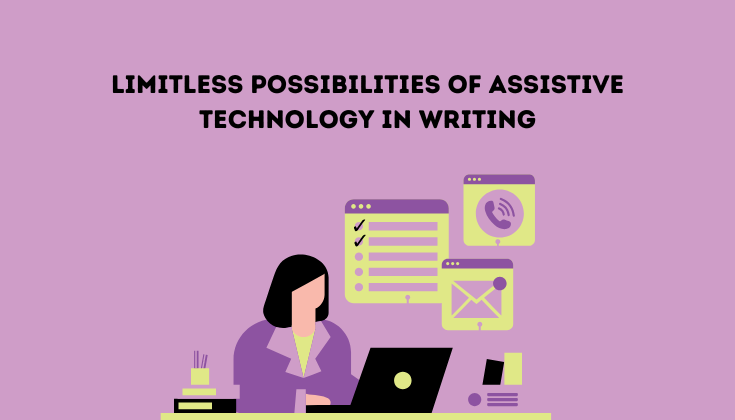Assistive technology has transformed the lives of individuals with disabilities, empowering them to overcome challenges and participate fully in various aspects of life. In the realm of writing, assistive technology has opened up a world of limitless possibilities, enabling individuals with physical, cognitive, or sensory impairments to express themselves, communicate effectively, and engage in written communication with ease. This article explores the diverse range of assistive technologies available today, highlighting their remarkable potential in enhancing writing capabilities and fostering inclusivity.
Limitless Possibilities of Assistive Technology in Writing
1- Speech-to-Text Technology
One of the most groundbreaking advancements in assistive technology for writing is speech-to-text technology. This technology allows individuals, including those seeking services from book writing services USA, to convert spoken words into written text, eliminating the physical barriers faced by those with limited motor skills or dexterity. By simply speaking into a microphone or a device, users can effortlessly transform their thoughts into written content. Speech-to-text software and applications, such as Dragon NaturallySpeaking and Google Docs Voice Typing, have become increasingly accurate, user-friendly, and accessible, offering a seamless writing experience.
2- Text-to-Speech Technology
Text-to-speech technology is another powerful tool that has revolutionized writing for individuals with visual impairments or reading difficulties. This technology enables written content to be converted into spoken words, allowing users to listen to text instead of reading it visually. Text-to-speech software, like NaturalReader and Voice Dream Reader, can read out the text from various sources, including digital documents, websites, and eBooks. This empowers individuals to access and comprehend written information, enhancing their ability to conduct research, gather knowledge, and engage in written communication.
3- Word Prediction Software
Word prediction software is a valuable assistive technology that aids individuals with writing difficulties or cognitive impairments. These programs suggest words or phrases based on the context of what the user is writing, allowing them to select the desired word with a simple keystroke. Word prediction software, such as CoWriter, and WordQ, not only enhances writing speed and efficiency but also supports vocabulary development and improves spelling and grammar skills. This technology promotes independence and autonomy in writing, reducing frustration and boosting confidence.
4- Grammar and Spell Checkers
For individuals who struggle with grammar and spelling, grammar and spell checkers provide indispensable assistance. These tools automatically identify and correct errors in writing, ensuring that individuals can produce well-structured, accurate, and professional content. Popular grammar checker and spell checkers like Grammarly and Microsoft Word built-in spell checker offer real-time feedback, suggesting corrections and providing explanations for improved writing skills. These tools are not only beneficial for individuals with learning disabilities but also for non-native English speakers seeking to enhance their writing proficiency.
5- Visual and Graphic Organizers
Visual and graphic organizers are assistive technologies that help individuals with cognitive impairments or organizational difficulties to plan, structure, and outline their writing. These tools provide a visual representation of ideas, allowing users to arrange and connect concepts, create hierarchies, and build cohesive written content. Software applications like Inspiration and MindMeister enable users to create mind maps, flowcharts, and diagrams that serve as blueprints for their writing. By visualizing and organizing their thoughts, individuals can overcome writer’s block, improve logical reasoning, and produce more coherent and structured written work.
6- Adaptive Keyboards and Input Devices
Assistive technology also encompasses adaptive keyboards and input devices designed to accommodate individuals with physical disabilities or limited motor skills. These specialized devices feature larger keys, customizable layouts, and alternative input methods such as voice commands, eye tracking, or head pointers. Adaptive keyboards and input devices, such as the IntelliKeys keyboard and the Tobii Dynavox EyeMobile, enable individuals to interact with computers and write more comfortably, efficiently, and accurately. These tools offer the following benefits:
a) Customizable Layouts
Adaptive keyboards allow users to customize the layout of keys according to their specific needs. They can create a keyboard layout that suits their motor abilities and optimize key size, spacing, and arrangement. This customization ensures that individuals can comfortably and accurately access the keys, reducing the risk of typing errors and increasing writing speed.
b) Alternative Input Methods
For individuals who have limited or no use of their hands, adaptive input devices offer alternative methods for interacting with computers and writing. Voice commands allow users to dictate their text while eye-tracking technology enables individuals to type by using their eye movements to select letters on the screen. Head pointers, which are controlled by head movements, can be used to navigate and type. These alternative input methods empower individuals to overcome physical limitations and engage in writing activities independently.
c) Switch Access
Adaptive keyboards and input devices often support switch access, allowing individuals to use external switches to input keystrokes. Switches can be activated by various body parts, such as hands, feet, or even the head, depending on the individual’s motor capabilities. This feature enables individuals with limited mobility to participate in writing activities, fostering independence and inclusivity.
d) Ergonomic Design
Adaptive keyboards are designed with ergonomic considerations, promoting comfort and reducing strain on the user’s hands and wrists. The larger keys and adjustable keyboard angles help minimize repetitive motion injuries and alleviate discomfort associated with extended writing sessions. By providing a more comfortable writing experience, adaptive keyboards enable individuals to focus on their ideas and creativity without the distraction of physical discomfort.
e) Compatibility with Assistive Software
Adaptive keyboards and input devices are often compatible with assistive software and applications, further expanding their functionality. Users can combine the features of adaptive keyboards with speech-to-text, word prediction, or other writing assistance tools to enhance their writing experience. This integration allows individuals to leverage the benefits of multiple assistive technologies, tailoring the writing process to their specific needs and maximizing their writing potential.
Conclusion
Assistive technology has opened up a world of limitless possibilities in the realm of writing, empowering individuals with disabilities to express themselves, communicate effectively, and engage in written communication. From speech-to-text technology to adaptive keyboards and input devices, these innovative tools have transformed the writing experience for individuals with physical, cognitive, or sensory impairments.
By harnessing the power of assistive technology, we can create a more inclusive and accessible writing environment, where everyone has the opportunity to share their thoughts, ideas, and stories with the world. As technology continues to advance, the future holds even greater potential for assistive technology in revolutionizing the writing landscape, breaking down barriers, and unlocking the full creative potential of individuals with diverse abilities.




